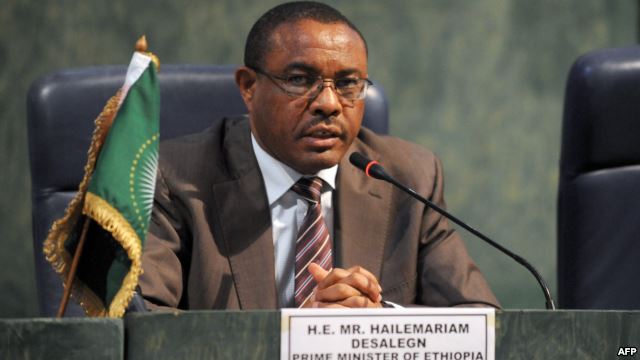 Prime Minister Hailemariam Desalegn, who is also the current chairperson of the African Union, speaks during a joint press conference at the end of the African Union Summit in Abuja, July 16, 2013. (AFP)
Prime Minister Hailemariam Desalegn, who is also the current chairperson of the African Union, speaks during a joint press conference at the end of the African Union Summit in Abuja, July 16, 2013. (AFP)
BY Marthe van der Wolf
ADDIS ABABA — It has been almost one year since Hailemariam Desalegn came to power in Ethiopia, following the death of his predecessor Meles Zenawi. Despite recent demonstrations and a cabinet shuffle, little seems to have changed in the East African country.
After weeks of speculation, Prime Minister Meles Zenawi’s death was announced last year, on the morning of August 21st. The passing of the longtime ruler made way for his deputy Hailemariam Desalegn, to lead the second most populous nation on the African continent.
Ethiopia witnessed several anti-government demonstrations in recent months, a rare sight. And the new prime minister also replaced most of the cabinet.
But a spokesperson for the prime minister, Getachew Redda, said these developments are not part of any fundamental change within the government.
“What Hailemariam is doing at this point is implementing the policies that have been adopted by the ruling party,” Redda explained. “If there were people who were expecting any kind of change in terms of directions and fundamental policies then they will definitely be disappointed because there was neither the intention nor the tendency to bring about any change whatsoever in this regard.”
Collective leadership
Hailemariam, an engineer by training, was the minister of foreign affairs and deputy prime minister until last August. With the appointment of Hailemariam, a collective leadership was put in place. Although government officials said that a collective leadership was always part of the ruling party’s policy.
Solomon Dersso, a political analyst for the Institute for Security Studies, said that political power is no longer centered in the position of the prime minister. But he doubts whether it will change Ethiopia’s political scene.
“The only thing that it would change is how decision making is negotiated within the ruling party between the different power centers,” Dersso said. “So you have regional governments becoming quite important, you have the members of the coalition, and of course the security apparatus. So on various aspects of the management of the affairs of the country obviously these different centers of power negotiations need to be undertaken.”
Girma Seifu, the only opposition member of parliament in Ethiopia for UDJ (Unity for Democracy and Justice), one of the parties that organized demonstrations in recent weeks, said that Prime Minister Hailemariam behaves differently in parliament from his predecessor. “In the previous, the prime minister is everything. So he is the law of the country,” Seifu noted. “So at that time the parliament was irrelevant.”
Human Rights
Despite those differences in character, Seifu feels the Ethiopian government has not changed its position on allowing more freedom for people who hold different opinions.
“They must do something visible to change the human rights situation in this country. They must take this thing seriously and they have to take action to improve these things. Only economic development issues, infrastructure issues will not substitute human rights issue,” Seifu said.
Ethiopia has been ruled by a coalition of four parties, the Ethiopian People’s Revolutionary Democratic Front, since 1991 with Meles Zenawi as its leader until his death. Current Prime Minister Hailemariam is expected to run for office during the 2015 elections. He hasn’t been very visible in his first year, but spokesperson Getachew said that this will change during his second year in office. “What you can expect from his leadership is a much closer engagement with the public, much more progressive attitude towards the development of the democratic process,” he remarked. “And a much more economic growth.”
Ethiopian statistics claim the country has had double-digit growth for the last few years, although the World Bank and IMF estimate the growth is around eight percent. The country is halfway through implementing its ambitious five-year Growth and Transformation Plan that is aimed at turning Ethiopia into a middle-income country by 2025.
—
Join the conversation on Twitter and Facebook

























